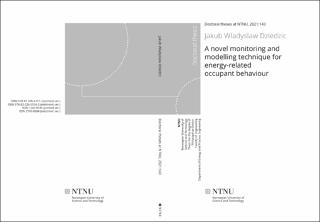| dc.contributor.advisor | Novakovic, Vojislav | |
| dc.contributor.advisor | Yan, Da | |
| dc.contributor.advisor | Georges, Laurent Francis Ghisl | |
| dc.contributor.author | Dziedzic, Jakub Wladyslaw | |
| dc.date.accessioned | 2021-04-19T08:03:42Z | |
| dc.date.available | 2021-04-19T08:03:42Z | |
| dc.date.issued | 2021 | |
| dc.identifier.isbn | 978-82-326-5534-2 | |
| dc.identifier.issn | 2703-8084 | |
| dc.identifier.uri | https://hdl.handle.net/11250/2738254 | |
| dc.description.abstract | The present work focuses on the development of a novel application that aims to better understand energy-related indoor occupant behaviour (OB). The thesis briefly introduces the key features of OB, presents the current state of the art and highlights the present challenges related to this field. The goal of the thesis is to present how potential challenges can be addressed with the use of a novel monitoring technique for in-situ occupant tracking. It is a depth registration technique that has practical implementations in various applications focusing on surface scanning. The main goal of the use of this technique in OB studies is to increase the quality of the measurement resolution to better understand the reasons for occupant activities regarding indoor energy use. It is expected that with an increase in the measurement resolution, it will be possible to observe and collect new information about occupants and their energy utilization. Therefore, it will be possible to detect avoidable waste of energy.
The proposed monitoring technique has not previously been commercially implemented in this research domain. Thus, there were no guidelines allowing for quick implementation. The methodology presented in the thesis describes step-by-step all the basic information required to understand the ideas and proposals for device utilization. Extended explanations are included in the appendices, and each subchapter refers to relevant appendices. Beyond the direct monitoring of occupants, the thesis explains the use of the collected data and shows how the data can be implemented in an agent-based model (ABM). The proposed model focuses on direct simulation of an occupant’s activities by recreating these activities through the portrayal of the occupant as an agent. The main functionalities that are provided by the model enable simulation of occupant movement, sensation of the thermal environment, interaction with indoor appliances and decision-making processes. The results obtained from the simulation show that a novel approach for the simulation of occupants is achievable. The OB represented by the ABM can be implemented as a calculation engine, which considers the occupant’s actions as activity triggers. The model is designed to connect various scientific specialities that focus on OB aspects, and combines each of the aspects into one common platform. The communication between scientific specialities that can be initialised by the proposed platform will bring a greater understanding of energy-related OB. Consequently, it may lead to a greater reduction in the use of energy resources without compromising occupants’ indoor comfort. | en_US |
| dc.language.iso | eng | en_US |
| dc.publisher | NTNU | en_US |
| dc.relation.ispartofseries | Doctoral theses at NTNU;2021:143 | |
| dc.relation.haspart | Paper 1: ziedzic, Jakub Wladyslaw; Yan, Da; Novakovic, Vojislav. Occupant migration monitoring in residential buildings with the use of a depth registration camera. Procedia Engineering 2017 ;Volum 205. s. 1193-1200
https://doi.org/10.1016/j.proeng.2017.10.352
Published Under a Creative Commons license Attribution-NonCommercial-NoDerivatives 4.0 International (CC BY-NC-ND 4.0) | en_US |
| dc.relation.haspart | Paper 2: J. Dziedzic, D. Yan, V. Novakovic; Measurement of Dynamic Clothing Factor (D-CLO); Proceedings of the 4th International Conference on Building Energy & Environment 2018; 208-212. Conference Paper | en_US |
| dc.relation.haspart | Paper 3: Dziedzic, Jakub Wladyslaw; Yan, Da; Novakovic, Vojislav. Real Time Measurement of Dynamic Metabolic Factor (D-MET). I: Cold Climate HVAC 2018 - Sustainable Buildings in Cold Climates. CCC 2018. Springer Proceedings in Energy. s. 677-688
https://doi.org/10.1007/978-3-030-00662-4_57 | en_US |
| dc.relation.haspart | Paper 4: Dziedzic, Jakub Wladyslaw; Novakovic, Vojislav. Occupant behavior modeling based on migration registration technique. IOP Conference Series: Materials Science and Engineering 2018 ;Volum 415.(1) s. 1-9
https://doi.org/10.1088/1757-899X/415/1/012044
Content from this work may be used under the terms of the Creative Commons Attribution 3.0 licence. (CC BY 3.0) | en_US |
| dc.relation.haspart | Paper 5: Dziedzic, Jakub Wladyslaw; Yan, Da; Novakovic, Vojislav. Indoor occupant behaviour monitoring with the use of a depth registration camera. Building and Environment 2019 ;Volum 148. s. 44-54
https://doi.org/10.1016/j.buildenv.2018.10.032 | en_US |
| dc.relation.haspart | Paper 6: Dziedzic, Jakub Wladyslaw; Yan, Da; Novakovic, Vojislav. Framework for a transient energy-related occupant behaviour agent-based model. REHVA European HVAC Journal 2019 ;Volum 5. s. 39-46 | en_US |
| dc.relation.haspart | Paper 7: Zone layout simulator for energy-related occupant behaviour modelling; Proceedings of the 11th International Symposium on Heating, Ventilation and Air Conditioning (ISHVAC 2019), 2020 Conference Paper | en_US |
| dc.relation.haspart | Paper 8: Dziedzic, Jakub Wladyslaw; Yan, Da; Novakovic, Vojislav. Evaluation of the occupants' exposition to the indoor environment. IOP Conference Series: Materials Science and Engineering 2019 ;Volum 609.(4)
https://doi.org/10.1088/1757-899X/609/4/042066
Content from this work may be used under the terms of the Creative Commons Attribution 3.0 licence. (CC BY 3.0) | en_US |
| dc.relation.haspart | Paper 9: Dziedzic, Jakub Wladyslaw; Yan, Da; Sun, Hongsan; Novakovic, Vojislav. Building occupant transient agent-based model – Movement module. Applied Energy 2020 ;Volum 261.
https://doi.org/10.1016/j.apenergy.2019.114417 | en_US |
| dc.relation.haspart | Paper 10: Dziedzic, Jakub Wladyslaw; Da, Yan; Novakovic, Vojislav.
Exploring possibilities to quantify the qualitative description of occupant behaviour. I: International Conference Organised by IBPSA-Nordic,
OsloMet. BuildSIM-Nordic 2020. SINTEF Proceedings no 5 s. 333-342
This is an open access publication under the CC BY-NC-ND license
(http://creativecommons.org/licenses/by-nc-nd/4.0/). | en_US |
| dc.relation.haspart | Paper 11: A. Das, J. Dziedzic, M. Annaqeeb, V. Novakovic, M. B. Kjærgaard; Human Activity Recognition Using Data Fusion and Deep Learning Methods, Proceedings of the ACM on Interactive, Mobile, Wearable and Ubiquitous Technologies. | en_US |
| dc.title | A novel monitoring and modelling technique for energy-related occupant behaviour | en_US |
| dc.type | Doctoral thesis | en_US |
| dc.subject.nsi | VDP::Technology: 500::Environmental engineering: 610 | en_US |

